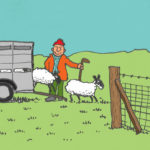Succession Planning - Crofting
If you're struggling with succession then you may find our new interactive tool will help you through the process and there's more information below it to guide you.
A Guide to Succession for Farmers and Crofters
This guide to succession is aimed at farmers and crofters of all ages and stages in their careers. This guide is not designed to give the reader a definitive answer for their own business - every farm and croft is so very different that understanding the requirements for the business and the individuals means a bespoke solution is needed. Its purpose is to start the process by creating awareness and perhaps providing the push required to start the conversation.
Assignation
Assignation is the term used to describe the transfer of a croft tenancy from a tenant crofter, referred to as the ‘assignor’ or ‘outgoing tenant’, to a person of their choice referred to as the ‘assignee’ or ‘proposed new tenant’.
If you want to know more about assignation, this page will take you step-by-step through the processes you need to do and consider if you are about to assign your croft. For example, whether you need to do the Crofting Register, or exclude any buildings.

Do you know your status?
It is very important that you know your croft tenancy/ownership status, as this affects the options available for succession. Are you a
- croft tenant
- owner-occupier
- owner occupier with tenanted grazing shares
- landlord of a vacant croft, or
- tenant of part of a croft and landlord of a part vacant croft – this is the case if you purchased part, but not all of a croft.
If you are unsure of your status consult the Register of Crofts (ROC) online https://www.crofting.scotland.gov.uk/register-of-crofts-roc
This status affects what process and forms you need to complete.
Croft tenants can:
- Put in a sub-tenant for a term of up to 10 years
- Assign their tenancy permanently
Owner-Occupiers can:
- Apply for someone to have a short let of the their croft
- Apply to transfer the land ownership via a solicitor
Landlord of a vacant croft:
- You could let this to establish a tenancy
- Transfer the land ownership via a solicitor
Duties of the Crofter
When planning succession it is important that your successors will be able to meet the duties of a crofter:
- To be resident within 32km of your croft
- To cultivate your croft
- Not to neglect your croft
Living Transfer – Implications for your House
If you intend to continue to live in your house on the croft it is important that you understand the implications of the house status:
- If the house is de-crofted
If the house is de-crofted then any changes you make to the croft will not affect your house.
2. If the house is not de-crofted
In this case, any changes to the croft will affect your house as well. You may wish to de-croft your house before assigning the tenancy or transferring ownership.
If you wish for the croft house to remain part of the croft but for you to live there until your death, a solicitor can arrange a life rental agreement. Please note that this can have an effect on successors’ ability to obtain Croft House Grant Scheme (CHGS) for a new house.
Croft Registration
It may be wise to get your croft registered when you are able to identify and agree the boundaries fully with neighbours, which may not be so simple as the next generation comes into the township and knowledge may be lost.
Key Points of Croft Wills
- Make sure you know your croft status
- Make sure your Will is up to date
- Make sure you mention the grazings shares
- Make sure the solicitor has knowledge of crofting law
- Make sure you are specific as to who you are leaving the croft to
- Is your house part of the croft or is it de-crofted? Have you made specific provision for who inherits the house?
Difficulties of Intestate Succession
If the deceased has no Will or the Will is not able to be affected then the succession is termed “intestate”. The Crofting Commission advises: “This is a complicated area of law and you should seek independent legal advice from a solicitor in cases of intestate succession.” There are strict timescales that come into play with this type of succession also. This situation is best avoided if at all possible.
Sign up to the FAS newsletter
Receive updates on news, events and publications from Scotland’s Farm Advisory Service

